Abstract
The broad clinical application of positive and expiratory pressure (PEEP) in the treatment of a variety of respiratory disorders has led to the observation that positive airway pressure can result in cardiac dysfunction. Recent attempts to integrate and extend the results of past research have led to diverse explanations of the overall cardiopulmonary effects of PEEP. This review summarizes previous work in the field and attempts to explain the basis of the divergent conclusions of previous investigators. Data are presented from several experimental models, as well as studies in postoperative patients to formulate an overall analysis of the influence of airway pressure on the central circulation. It appears that the effects of PEEP are primarily mechanical and are mediated through a combination of right ventricular preload limitation and outflow obstruction. Both effects are additive in limiting left ventricular preload and can be ameliorated by volume loading in the absence of significant right ventricular or pulmonary vascular disease. Neural, humoral and ventricular interactive forces appear to be insignificant under most circumstances. The clinical implications of these advances in the current understanding of PEEP are reviewed.
Full text
PDF
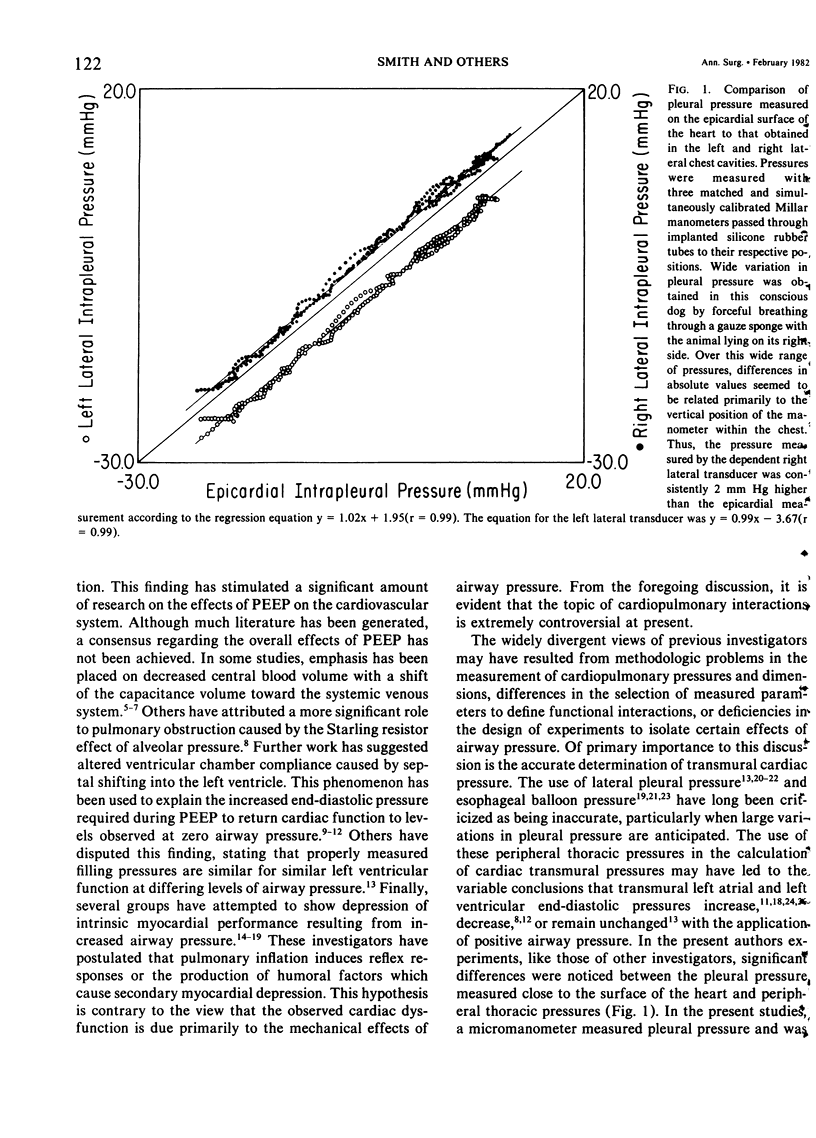

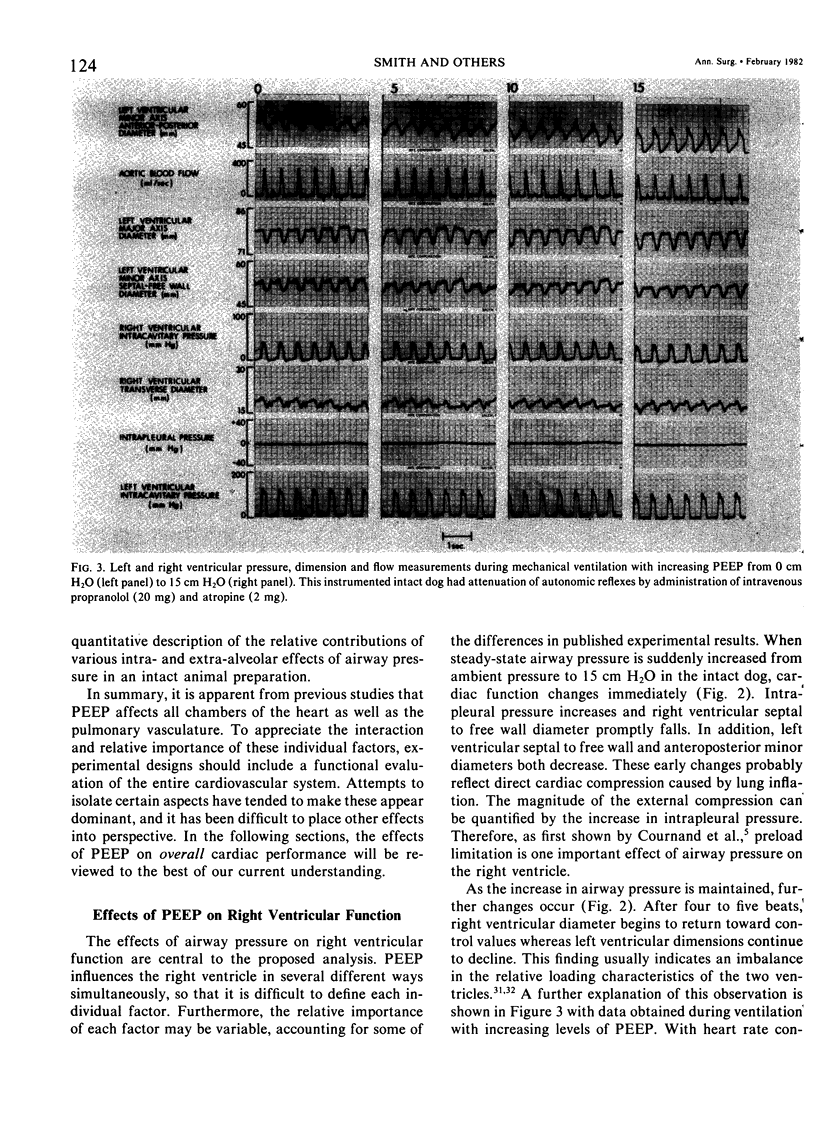
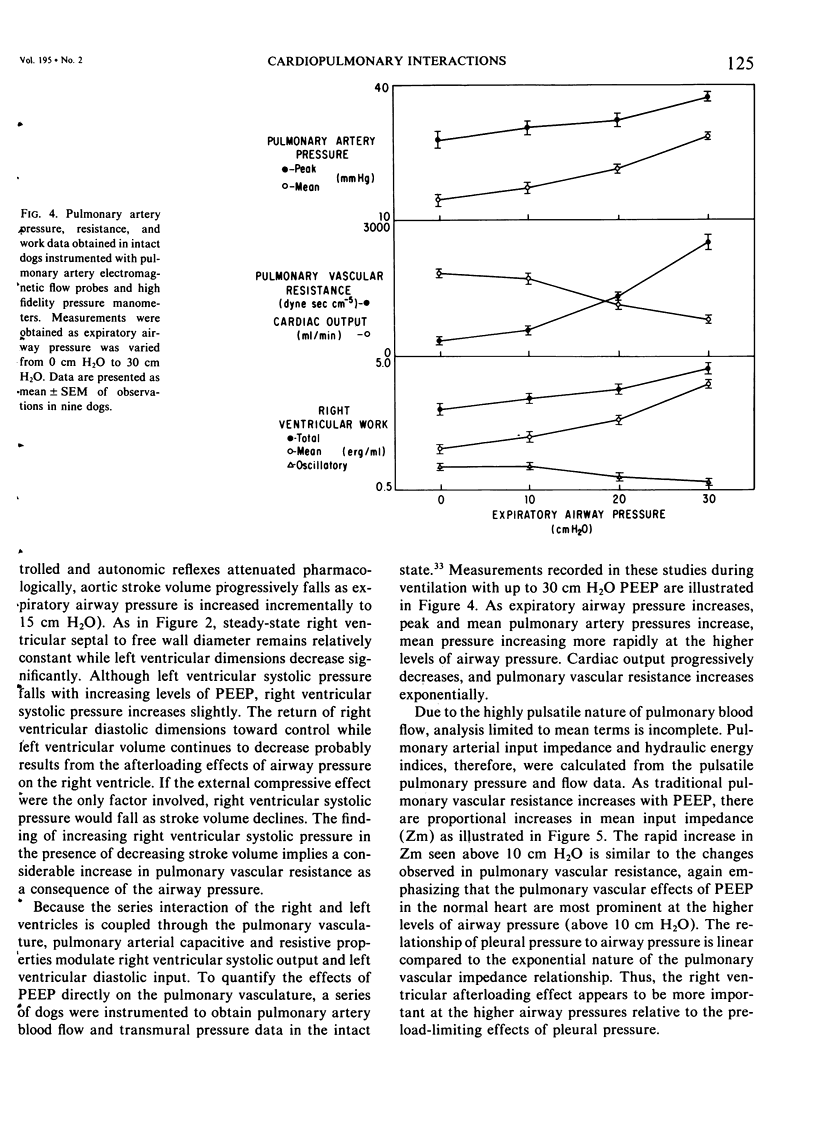
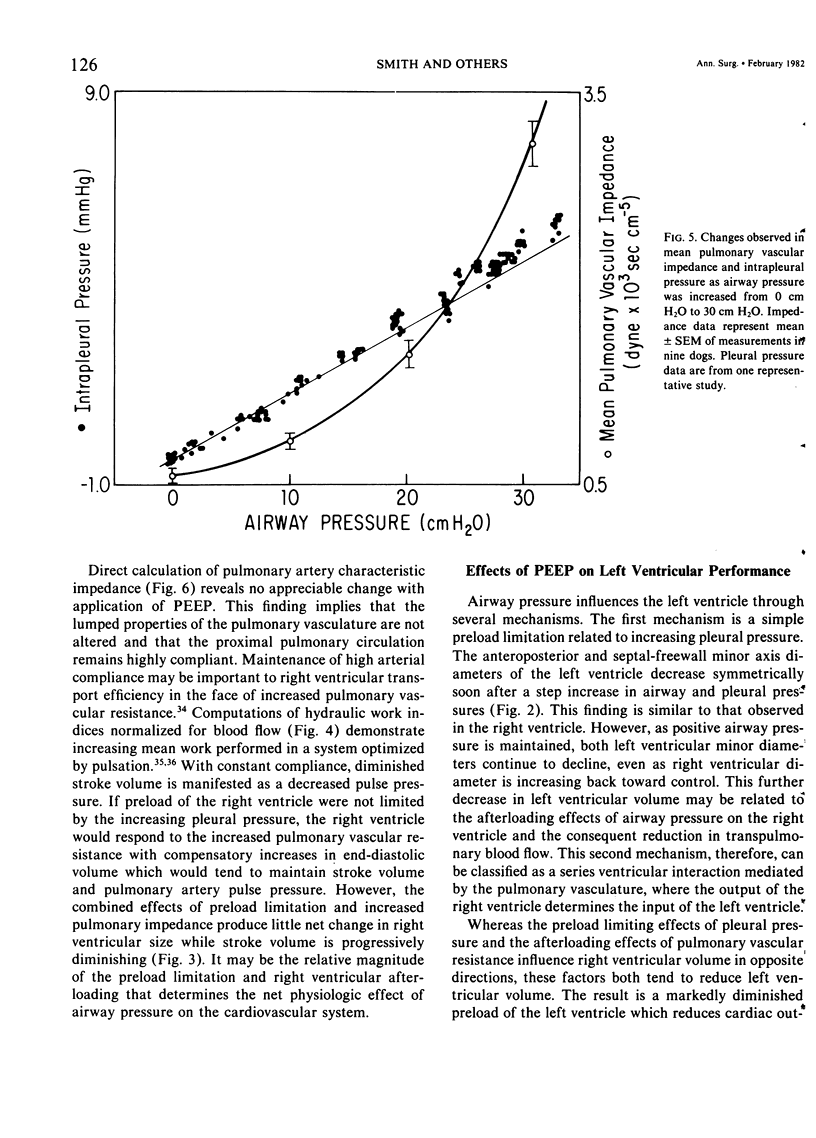
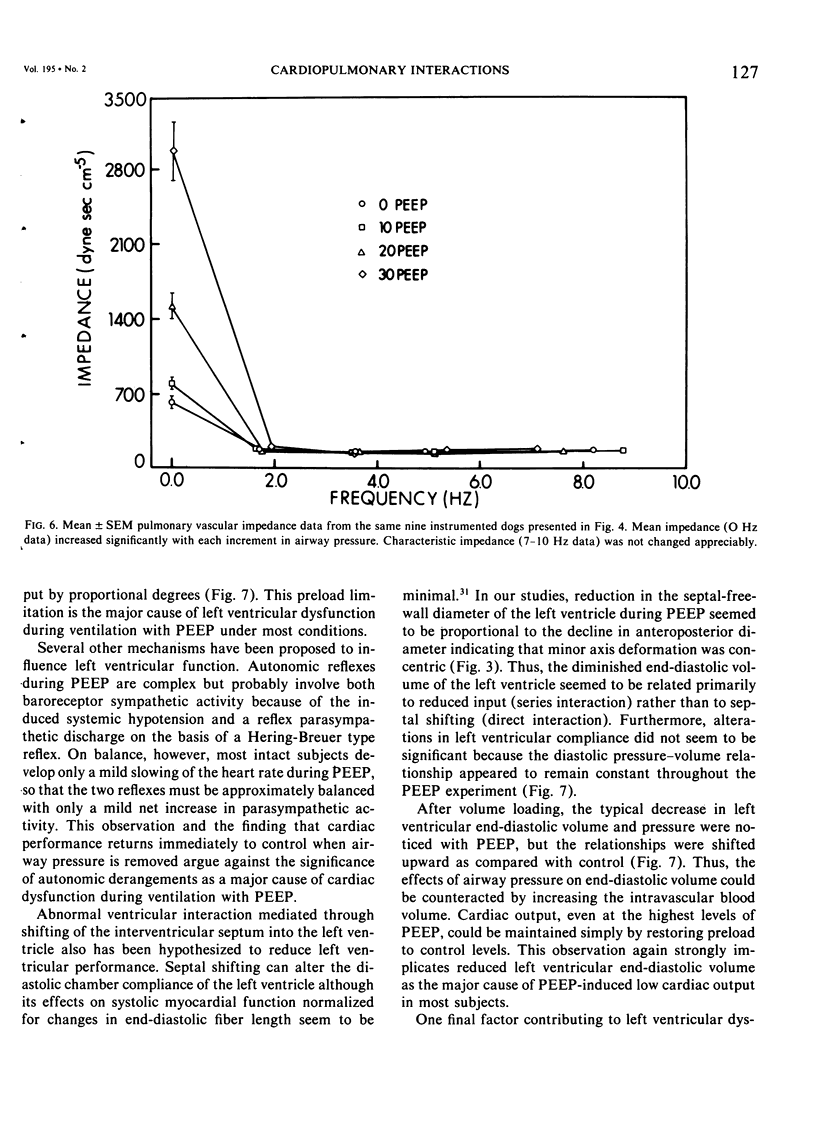
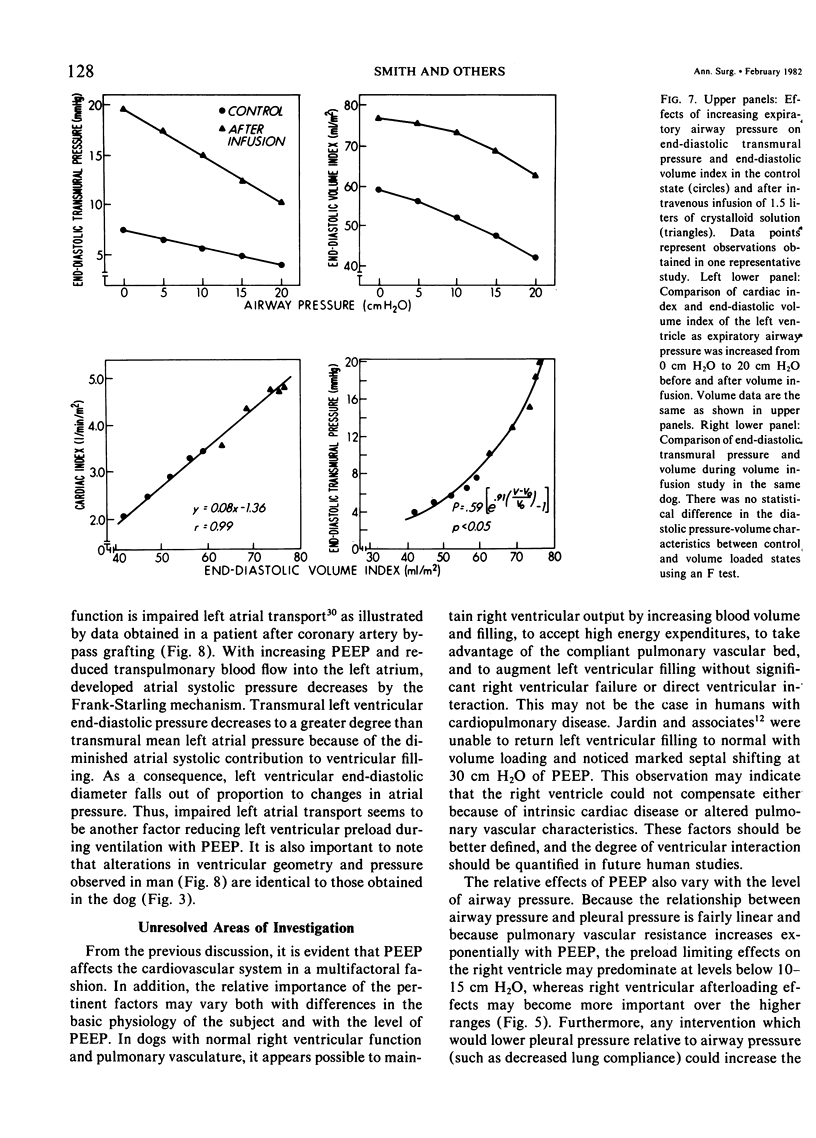
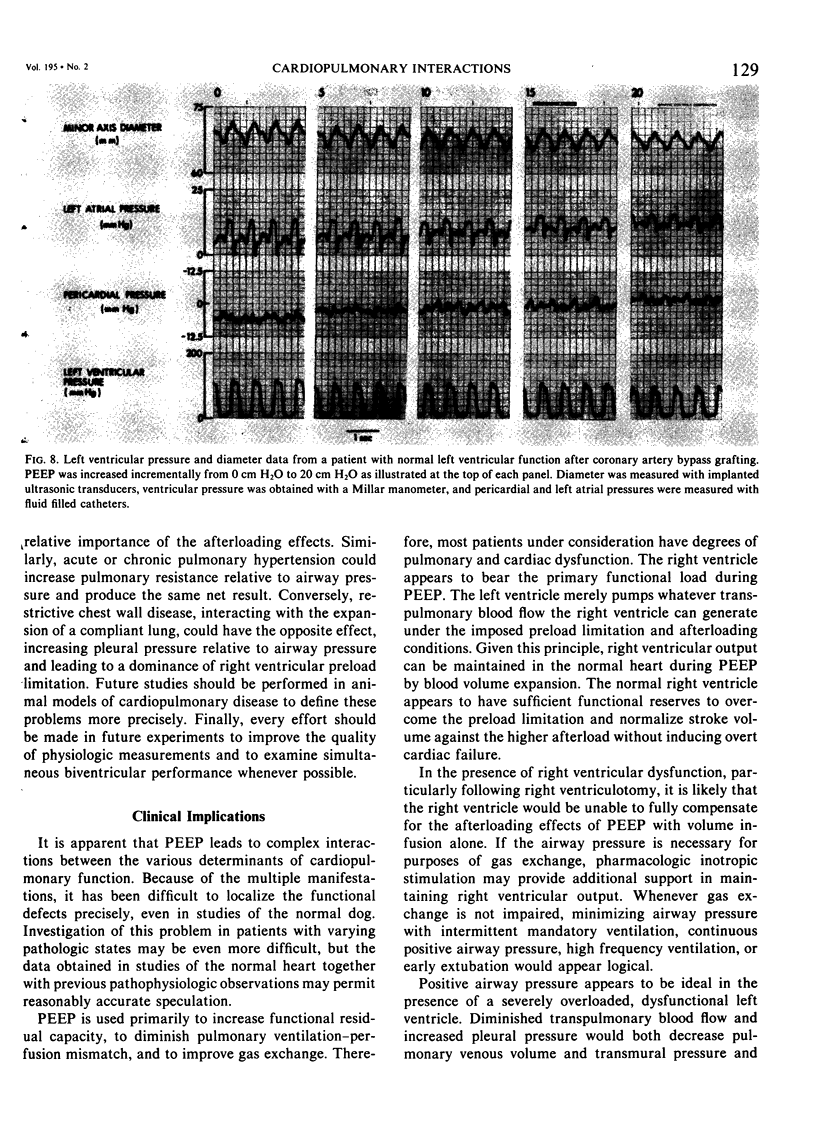
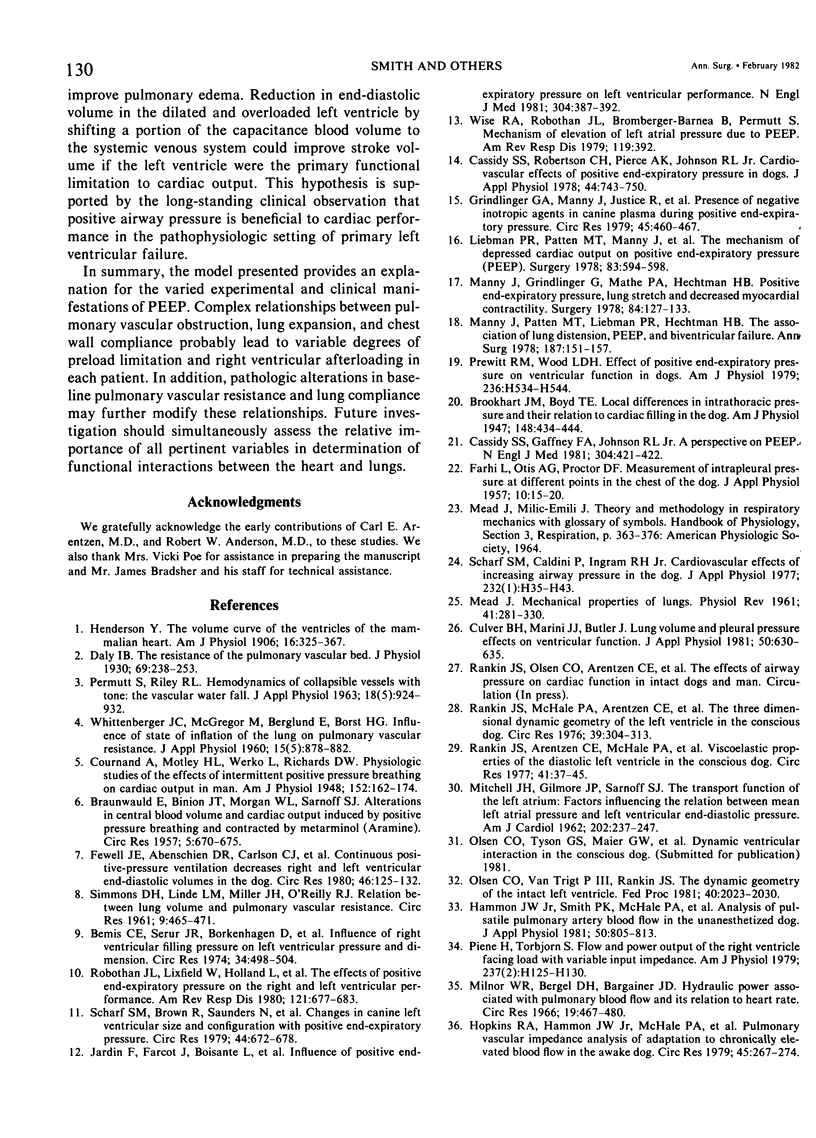
Images in this article
Selected References
These references are in PubMed. This may not be the complete list of references from this article.
- BRAUNWALD E., BINION J. T., MORGAN W. L., Jr, SARNOFF S. J. Alterations in central blood volume and cardiac output induced by positive pressure breathing and counteracted by metaraminol (aramine). Circ Res. 1957 Nov;5(6):670–675. doi: 10.1161/01.res.5.6.670. [DOI] [PubMed] [Google Scholar]
- Bemis C. E., Serur J. R., Borkenhagen D., Sonnenblick E. H., Urschel C. W. Influence of right ventricular filling pressure on left ventricular pressure and dimension. Circ Res. 1974 Apr;34(4):498–504. doi: 10.1161/01.res.34.4.498. [DOI] [PubMed] [Google Scholar]
- Cassidy S. S., Gaffney F. A., Johnson R. L., Jr A perspective on PEEP. N Engl J Med. 1981 Feb 12;304(7):421–422. doi: 10.1056/NEJM198102123040710. [DOI] [PubMed] [Google Scholar]
- Cassidy S. S., Robertson C. H., Jr, Pierce A. K., Johnson R. L., Jr Cardiovascular effects of positive end-expiratory pressure in dogs. J Appl Physiol Respir Environ Exerc Physiol. 1978 May;44(5):743–750. doi: 10.1152/jappl.1978.44.5.743. [DOI] [PubMed] [Google Scholar]
- Culver B. H., Marini J. J., Butler J. Lung volume and pleural pressure effects on ventricular function. J Appl Physiol Respir Environ Exerc Physiol. 1981 Mar;50(3):630–635. doi: 10.1152/jappl.1981.50.3.630. [DOI] [PubMed] [Google Scholar]
- Daly I. de B. The resistance of the pulmonary vascular bed. J Physiol. 1930 Apr 14;69(2):238–253. doi: 10.1113/jphysiol.1930.sp002647. [DOI] [PMC free article] [PubMed] [Google Scholar]
- FARHI L., OTIS A. B., PROCTOR D. F. Measurement of intrapleural pressure at different points in the chest of the dog. J Appl Physiol. 1957 Jan;10(1):15–18. doi: 10.1152/jappl.1957.10.1.15. [DOI] [PubMed] [Google Scholar]
- Fewell J. E., Abendschein D. R., Carlson C. J., Murray J. F., Rapaport E. Continuous positive-pressure ventilation decreases right and left ventricular end-diastolic volumes in the dog. Circ Res. 1980 Jan;46(1):125–132. doi: 10.1161/01.res.46.1.125. [DOI] [PubMed] [Google Scholar]
- Grindlinger G. A., Manny J., Justice R., Dunham B., Shepro D., Hechtman H. B. Presence of negative inotropic agents in canine plasma during positive end-expiratory pressure. Circ Res. 1979 Oct;45(4):460–467. doi: 10.1161/01.res.45.4.460. [DOI] [PubMed] [Google Scholar]
- Hammon J. W., Jr, Smith P. K., McHale P. A., Vanbenthuysen K. M., Anderson R. W. Analysis of pulsatile pulmonary artery blood flow in the unanesthetized dog. J Appl Physiol Respir Environ Exerc Physiol. 1981 Apr;50(4):805–813. doi: 10.1152/jappl.1981.50.4.805. [DOI] [PubMed] [Google Scholar]
- Hopkins R. A., Hammon J. W., Jr, McHale P. A., Smith P. K., Anderson R. W. Pulmonary vascular impedance analysis of adaptation to chronically elevated blood flow in the awake dog. Circ Res. 1979 Aug;45(2):267–274. doi: 10.1161/01.res.45.2.267. [DOI] [PubMed] [Google Scholar]
- Jardin F., Farcot J. C., Boisante L., Curien N., Margairaz A., Bourdarias J. P. Influence of positive end-expiratory pressure on left ventricular performance. N Engl J Med. 1981 Feb 12;304(7):387–392. doi: 10.1056/NEJM198102123040703. [DOI] [PubMed] [Google Scholar]
- Liebman P. R., Patten M. T., Manny J., Shepro D., Hechtman H. B. The mechanism of depressed cardiac output on positive end-expiratory pressure (PEEP). Surgery. 1978 May;83(5):594–598. [PubMed] [Google Scholar]
- MEAD J. Mechanical properties of lungs. Physiol Rev. 1961 Apr;41:281–330. doi: 10.1152/physrev.1961.41.2.281. [DOI] [PubMed] [Google Scholar]
- MITCHELL J. H., GILMORE J. P., SARNOFF S. J. The transport function of the atrium. Factors influencing the relation between mean left atrial pressure and left ventricular end diastolic pressure. Am J Cardiol. 1962 Feb;9:237–247. doi: 10.1016/0002-9149(62)90043-7. [DOI] [PubMed] [Google Scholar]
- Manny J., Grindlinger G., Mathé A. A., Hechtman H. B. Positive end-expiratory pressure, lung stretch, and decreased myocardial contractility. Surgery. 1978 Jul;84(1):127–133. [PubMed] [Google Scholar]
- Manny J., Patten M. T., Liebman P. R., Hechtman H. B. The association of lung distention, PEEP and biventricular failure. Ann Surg. 1978 Feb;187(2):151–157. doi: 10.1097/00000658-197802000-00009. [DOI] [PMC free article] [PubMed] [Google Scholar]
- Milnor W. R., Bergel D. H., Bargainer J. D. Hydraulic power associated with pulmonary blood flow and its relation to heart rate. Circ Res. 1966 Sep;19(3):467–480. doi: 10.1161/01.res.19.3.467. [DOI] [PubMed] [Google Scholar]
- Olsen C. O., Van Trigt P., Rankin J. S. Dynamic geometry of the intact left ventricle. Fed Proc. 1981 May 15;40(7):2023–2030. [PubMed] [Google Scholar]
- PERMUTT S., RILEY R. L. HEMODYNAMICS OF COLLAPSIBLE VESSELS WITH TONE: THE VASCULAR WATERFALL. J Appl Physiol. 1963 Sep;18:924–932. doi: 10.1152/jappl.1963.18.5.924. [DOI] [PubMed] [Google Scholar]
- Prewitt R. M., Wood L. D. Effect of positive end-expiratory pressure on ventricular function in dogs. Am J Physiol. 1979 Apr;236(4):H534–H544. doi: 10.1152/ajpheart.1979.236.4.H534. [DOI] [PubMed] [Google Scholar]
- Rankin J. S., Arentzen C. E., McHale P. A., Ling D., Anderson R. W. Viscoelastic properties of the diastolic left ventricle in the conscious dog. Circ Res. 1977 Jul;41(1):37–45. doi: 10.1161/01.res.41.1.37. [DOI] [PubMed] [Google Scholar]
- Rankin J. S., McHale P. A., Arentzen C. E., Ling D., Greenfield J. C., Jr, Anderson R. W. The three-dimensional dynamic geometry of the left ventricle in the conscious dog. Circ Res. 1976 Sep;39(3):304–313. doi: 10.1161/01.res.39.3.304. [DOI] [PubMed] [Google Scholar]
- Robotham J. L., Lixfeld W., Holland L., MacGregor D., Bromberger-Barnea B., Permutt S., Rabson J. L. The effects of positive end-expiratory pressure on right and left ventricular performance. Am Rev Respir Dis. 1980 Apr;121(4):677–683. doi: 10.1164/arrd.1980.121.4.677. [DOI] [PubMed] [Google Scholar]
- Scharf S. M., Brown R., Saunders N., Green L. H., Ingram R. H., Jr Changes in canine left ventricular size and configuration with positive end-expiratory pressure. Circ Res. 1979 May;44(5):672–678. doi: 10.1161/01.res.44.5.672. [DOI] [PubMed] [Google Scholar]
- Scharf S. M., Caldini P., Ingram R. H., Jr Cardiovascular effects of increasing airway pressure in the dog. Am J Physiol. 1977 Jan;232(1):H35–H43. doi: 10.1152/ajpheart.1977.232.1.H35. [DOI] [PubMed] [Google Scholar]
- WHITTENBERGER J. L., McGREGOR M., BERGLUND E., BORST H. G. Influence of state of inflation of the lung on pulmonary vascular resistance. J Appl Physiol. 1960 Sep;15:878–882. doi: 10.1152/jappl.1960.15.5.878. [DOI] [PubMed] [Google Scholar]





